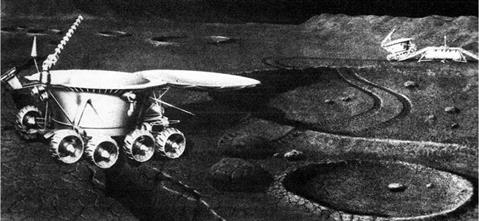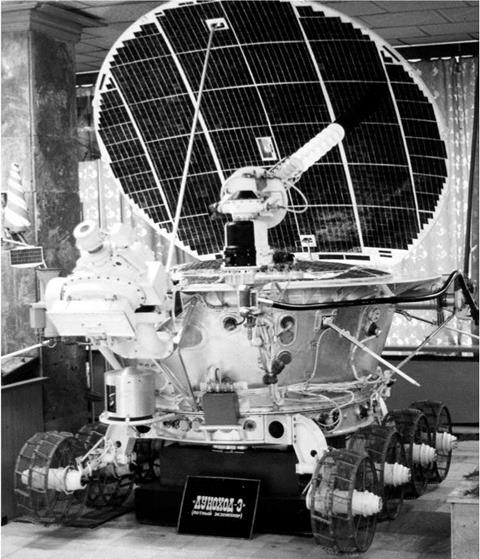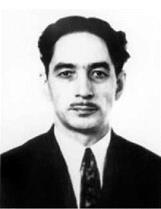WINDING DOWN THE PROGRAMME OF AUTOMATIC LUNAR EXPLORATION
Luna 24 was the last moon mission by the Soviet Union or Russia. Its return cabin, along with those from Luna 16 and 20, was given to the Lavochkin Museum. Twenty – five such cabins had been built altogether, both for flight and tests. Three still rest on the moon (Luna 15, 18, 23) and five were lost in rocket explosions.
During the period September 1970 to June 1973, a series of missions was promised to build on the successes of the lunar sample return and the Lunokhod. On Luna 16’s return, the Soviet media announced that the 1970s would be ‘the decade of the space robot’. Among the missions spoken about were: [12]
• Telescopes on the lunar farside.
• Automatic static observatories on the moon.
• Use of relay satellites to control and receive information from farside moon probes.
The use of Lunokhods to deliver rocks to a sample return craft would have been impressive. For this, the Lunokhod would have been fitted with a robot arm. Such a mission was sketched in detail and the rover would have been called Sparka, Russian for ‘pair’. Further into the future, VNII Transmash envisaged a ‘heavy Lunokhod’ which looked like an armoured personnel carrier, 4.7 m long, 4.3 m wide, with eight wheels, panels and dish aerials on top, eight 1,200 mm wheels and able to traverse very extensive distances [14].
The extensive discussion of plans for future moon probes in the Soviet press came to an abrupt end in June 1973. References to rovers were now made in the context of their achievements being used to design Mars rovers, rather than future moon rovers. The Soviet media barely reported the last set of missions. It seems that the decision was taken in summer 1973 to wind down the Ye-8 moon programme over the next four years, using up most of the already built hardware. Lunokhod 3 was built and ready to fly in 1977 as Luna 25, but ended up instead in the Lavochkin Museum. Lunokhod 3 was similar to Lunokhod 2, but with an improved camera system. The Proton rocket that should have brought it to the moon was given over to a communications satellite instead.
When Luna 24 returned to Earth, there was no official indication that the programme of unmanned lunar exploration had drawn to a close and, of course, the cancellation at the same time of the N1-L3M programme was not announced either. One winner from Luna 24 was Vladimir Barmin, who was now charged with developing a drill to dig into the rocks of Venus, his new machinery being carried on the forthcoming Venera 11 and 12 missions in 1978.
|
Lunokhods roam the moon |
|
Lunokhod 3 |
When Lunokhod 3 was cancelled, the lunar team was dispersed to the Venus missions. Oleg Ivanovsky, the deputy director and responsible for lunar probes, was put in charge of building an orbiting astronomical observatory, called Astron. Once this flew, successfully, in 1983, he retired, taking up a new voluntary post as head of the Lavochkin Museum. Other staff were assigned to other probes and missions.
All the scientists could do was content themselves with publishing the results of their investigations, both in the Soviet press and in collaborative publications abroad.
|
Valeri Barsukov |
Despite the heat of the moon race, scientists from the two countries were eager to share and compare the results of their analysis of the results of the moon missions. Many geologists made extensive cross-comparisons of the differences between the three Luna samples and the six Apollo samples, classifying them according to origin, type and composition. Even though the Luna samples were small, they were three distinct types: mare, highland and core. The glassy features of the Luna 16 rock were especially unusual. In the year after Luna 24’s return, NASA published the proceedings of the Soviet-American conference on the geochemistry of the moon and planets [15] and Soviet papers were published in other Western outlets, such as the journal The Moon. The NASA papers included the analysis of the moonrock collected by the Lunas and various articles, ranging from studies of the rocks from an individual mission to broader reviews, such as T. V. Malysheva’s The problem of the origin of the lunar maria and continents. Lunokhod 2 produced a rich seam of scientific papers, such as L. L. Vanyan’s Deep electronic sounding of the moon with Lunokhod 2, Measurement of sky brightness from Lunokhod 2 and Dolgov et al.’s: The magnetic field in Le Monnier Bay according to Lunokhod 2. Kiril Florensky’s Role of exogenic factors in the formation of the lunar surface included a series of hitherto unseen Lunokhod 2 pictures. The results of the very last mission were published by Nauka as Lunar soil from the Mare Crisium, by Valeri Barsukov, in 1980.
As for Alexander Kemurdzhian, the designer of the moonrovers, he wrote another thesis about his creations, obtaining a second doctorate and the title of professor. His STR-1 robot was involved in the investigation and cleanup of the Chernobyl nuclear disaster. Kemurdzhian exposed himself to so much radiation there that he had to be treated in the Moscow #20 hospital afterwards. He wrote 200 scientific works and patented 50 inventions. Almost eighty, he retired in 1998, though colleagues noticed little change in his output or energy and he was the chief speaker at the 30th anniversary of the Lunokhod meeting held in Tovstonogov in November 2000. His health deteriorated soon after this and he died on 24th February 2003 in the hospital which had treated him for radiation burns. Alexander Kemurdzhian was buried in the Armenian part of the Smolensky Cemetery in St Petersburg. Asteroid
# 5993 was named after him, and the International Biographic Centre named him one of the outstanding people of the 20th century.
|
Final round of moon missions
|
The Ye-8 series did eventually provide the Soviet Union with some form of credible alternative to Apollo and saved some face. The two Lunokhods attracted the most public attention and probably made the most popular impact. They were sophisticated vehicles of exploration and it was a loss to science that Lunokhod 3 was not flown. The soil sample return mission series, although technically difficult and impressive in their own right, cannot be said to have been a great success and the gains were achieved for a disproportionate effort. Although three missions did bring lunar samples back, their haul was small at 325 g, compared with Apollo’s 380 kg, while seven missions had failed altogether. The Ye-8LS lunar orbiters may well have achieved solid results, but they were poorly publicized or disseminated. The heart seems to have gone out of the programme in June 1973 and one has the impression that permission was given to fly already-built hardware on the understanding that there would be no further missions thereafter for the foreseeable future. By the time Luna 22 flew, the N-1 programme had been suspended and there was little reason to draw attention to the lunar programme generally. It is probably no coincidence that the last mission, in August 1976, took place only months after the N-1 was finally cancelled in March 1976. It seems that both the manned and unmanned programmes were run down in parallel.













